02.03.2019
Просмотров: 26179
Синий экран смерти INTERRUPT_EXCEPTION_NOT_HANDLED с цифровым кодом 0x0000003D чаще всего возникает на Windows 7 и на Windows 10. Поэтому рассматриваемые способы можно будет тестировать на обеих сборках.
Возникает такая неполадка после обновления операционной системы по причине сбоя в работе драйверов. Установленное программное обеспечение оказывается несовместимым с новыми компонентами Windows, а поэтому возникает ошибка 0x0000003D. Также, как было определено после анализа различных форумов, синий экран смерти INTERRUPT EXCEPTION NOT HANDLED часто появляется после возникновения проблем с жестким диском и оперативной памятью. Поэтому для решения такой неполадки придется провести комплекс диагностических действий.
Читайте также: Ошибка 0x00000006 – INVALID PROCESS DETACH ATTEMPT: причины и решение
Способы решения ошибки 0x0000003D: INTERRUPT EXCEPTION NOT HANDLED
Поскольку ошибка 0x0000003D: INTERRUPT_EXCEPTION_NOT_HANDLED на Windows 10 чаще всего возникает из-за повреждения системных файлов и драйверов, то первое, что нужно сделать, это запустить командную строку с правами Администратора и нажать sfc /scannow.
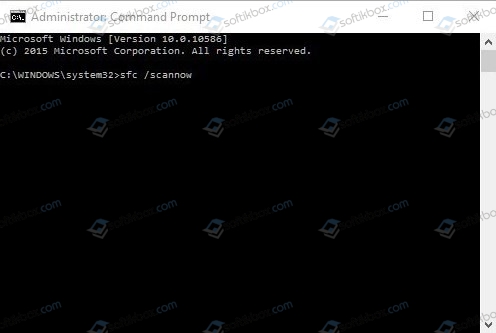
Если утилита не нашла поврежденных системных файлов, стоит сразу запустить инструмент для проверки диска. Для этого в консоли с правами Администратора вводим chkdsk C: /f, где С: — буква диска, /f – параметр команды для исправления найденных ошибок.
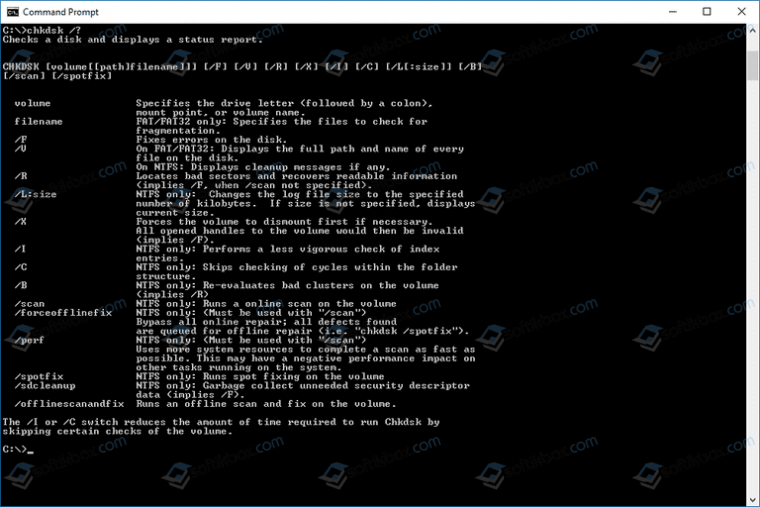
Если с системными файлами и жестким диском все в порядке, стоит перейти к обновлению драйверов или к откату их к более раннему состоянию.
Если вы обновляли операционную систему, то нужно включить малый дамп памяти и проанализировать, какой драйвер дает сбой. Затем переходим в «Диспетчер устройств». Разворачиваем ветку нужного устройства. Нажимаем на элементе правой кнопкой мыши и выбираем «Свойства». Откроется небольшое окно. Переходим во вкладку «Драйвер» и нажимаем на кнопку «Откатить». Выбираем причину, по которой хотим вернуть ПО к предыдущему состоянию.
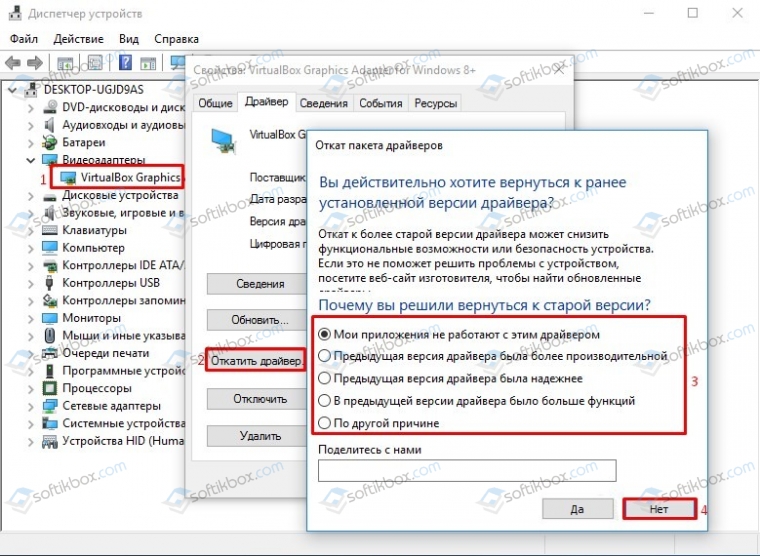
В случае, если вы не обновляли Windows, то драйвера, наоборот, нужно обновить. Для этого стоит скачать с официального сайта производителя программное обеспечение для вашей версии ОС, с учетом её разрядности. Далее необходимо перейти в той же «Диспетчер устройств», выбрать нужный элемент и нажать на нем правой кнопкой мыши. Здесь выбираем «Обновить драйвера».
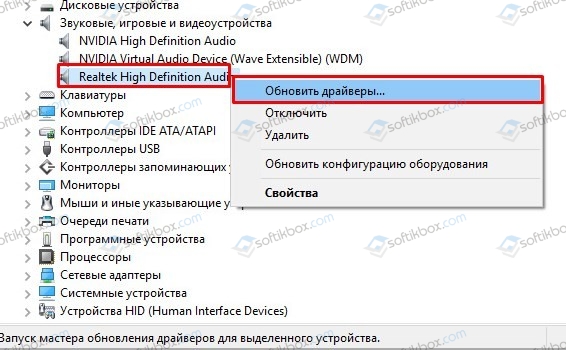
Появиться небольшое окно. Выбираем вариант «Выполнить поиск драйверов на этом ПК». Указываем папку, в которой расположен файл-драйвер. После обновления драйвера нужно перезагрузить систему.
Если вы не можете определить, какой драйвер сбоит, то нужно скачать любую программу для поиска и автоматического обновления драйверов и выполнить апдейт программного обеспечения.
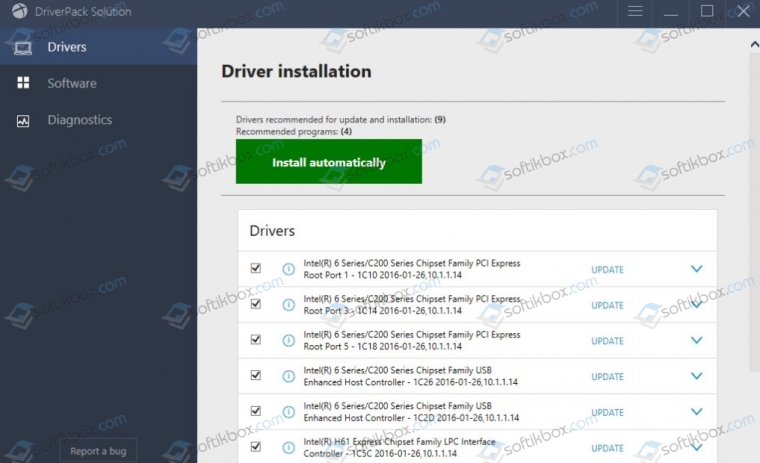
Если автоматическое обновление программного обеспечения не помогло решить проблему, рекомендуем выполнить проверку оперативной памяти на ошибки. Для этого стоит скачать и записать на флешку программу MemTest86. Запустить её нужно в обход Windows. Для этого в BIOSe необходимо выставить приоритетность загрузки со съемного носителя. А далее загрузиться с флешки и запустить несколько проходов данной программы.
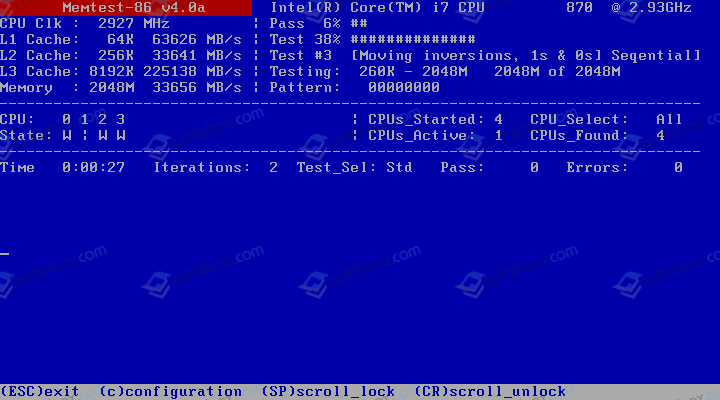
Также для полной уверенности нужно запустить проверку жесткого диска на наличие битых секторов. Для этого рекомендуем использовать программу Victoria HDD. Её также, как и MemTest86, нужно записать на съемный диск и запустить в обход Windows 10.
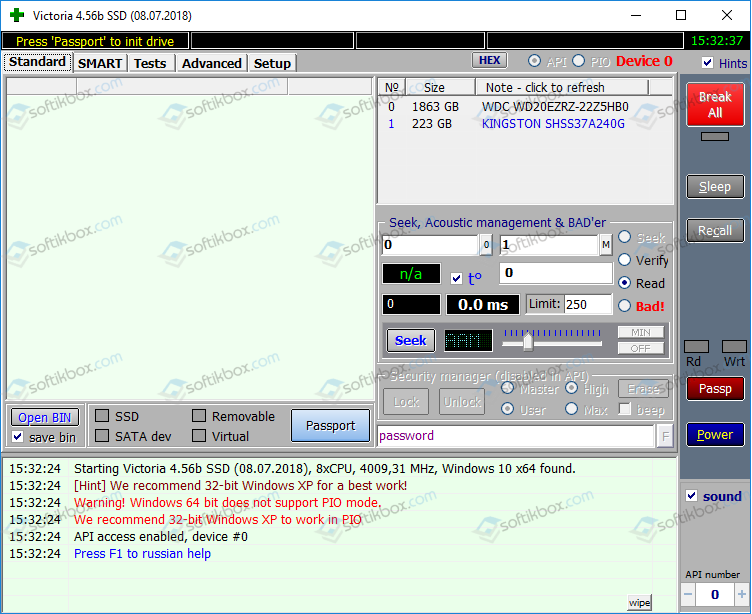
Если же и после диагностики и обновления драйверов исправить ошибку не удается, стоит выполнить чистую установку Windows 10 или полную её переустановку.
Skip to content
Как убрать INTERRUPT_EXCEPTION_NOT_HANDLED (0x0000003D)?
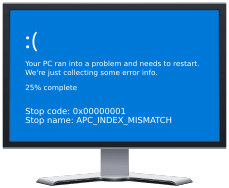
Как убрать « INTERRUPT_EXCEPTION_NOT_HANDLED» ( 0x0000003D)?
На компьютере или ноутбуке под управлением Windows появился «синий экран смерти»? После появления сообщения «
INTERRUPT_EXCEPTION_NOT_HANDLED» (
0x0000003D) система перезагружается? Ищите как исправить
0x0000003D: «
INTERRUPT_EXCEPTION_NOT_HANDLED»?
Как просмотреть информацию об ошибках, исправить ошибки в Windows 10, 8 или 7

Причины появления ошибки
- На жестком диске компьютера или ноутбука не достаточно места. Для правильной работы ОС Windows 10 на системном диске должно быть свободно 2 — 10 ГБ.
- На компьютер был установлен не совместимый BIOS или прошивка была повреждена.
- Установлены не совместимые с ОС драйвера устройств.
- Реестр Windows был поврежден или удален. Возможно в результате очистки были удалены системные ключи реестра.
- Ативирусное программное обеспечение или компьютерные вирусы могут заблокировать системные файлы или удалить важные ключи реестра.
- В результате ошибок в работе программы для резервного копирования.
- В результате обновления ОС Windows.
Актуально для ОС: Windows 10, Windows 8.1, Windows Server 2012, Windows 8, Windows Home Server 2011, Windows 7 (Seven), Windows Small Business Server, Windows Server 2008, Windows Home Server, Windows Vista, Windows XP, Windows 2000, Windows NT.
Вот несколько способов исправления ошибки «
INTERRUPT_EXCEPTION_NOT_HANDLED»:
Восстановите удаленные файлы
Часто появление BSoD ошибок приводит к утери важных файлов. Блокировка файлов компьютерными вирусами, ошибки в работе программ для резервного копирования, повреждение или перезапись системных файлов, ошибки файловой системы или наличие битых секторов диска – это не далеко полный список причин удаления данных.
Исправление соответствующих ошибок восстановит работоспособность устройства, но не всегда восстановит повреждённые или утерянные файлы. Не всегда имеется возможность устранить ту или иную ошибку без форматирования диска или чистой установки операционной системы, что также может повлечь за собой утерю файлов.
Загрузите бесплатно и просканируйте ваше устройство с помощью Hetman Partition Recovery. Ознакомьтесь с возможностями программы и пошаговой инструкцией.
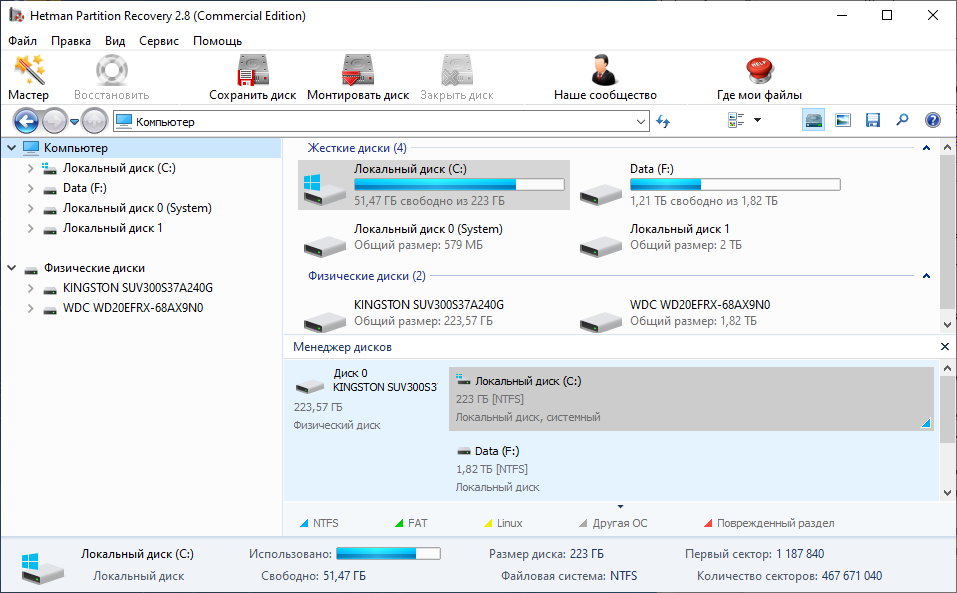
Программа для восстановления данных
Запустите компьютер в «безопасном режиме»
Если ошибка «INTERRUPT_EXCEPTION_NOT_HANDLED» (0x0000003D) возникает в момент загрузки Windows и блокирует любую возможность работы с системой, попробуйте включить компьютер в «безопасном режиме». Этот режим предназначен для диагностики операционной системы (далее ОС), но функционал Windows при этом сильно ограничен. «Безопасный режим» следует использовать только если работа с системой заблокирована.
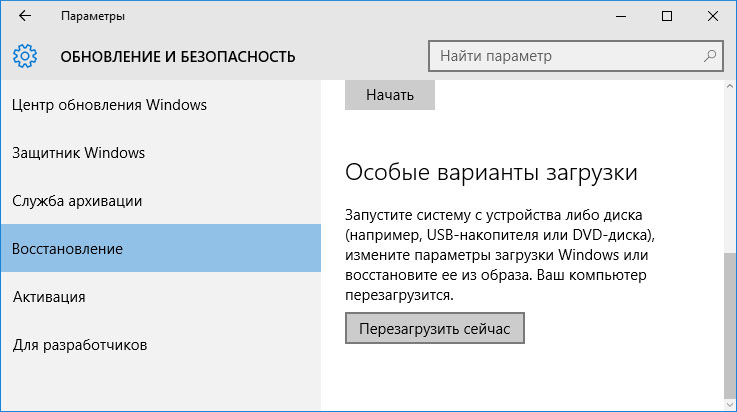
Чтобы запустить безопасный режим сделайте следующее:
- Перейдите в меню Пуск и выберите Параметры.
- В открывшемся окне параметров перейдите в меню Обновление и Безопасность и выберите раздел Восстановление.
- В разделе Восстановление найдите Особые варианты загрузки и нажмите кнопку Перезагрузить сейчас.
- После этого Windows перезагрузится и предложит выбрать следующее действие. Выберите Поиск и устранение неисправностей.
- В меню Поиск и устранение неисправностей кликните на Дополнительные параметры, далее — Параметры загрузки.
- Далее Windows уведомит вас о том, что компьютер можно перезагрузить с использованием дополнительных параметров загрузки. Укажите — Включить безопасный режим. Нажмите Перезагрузить.
- После перезагрузки выберите Включить безопасный режим нажав клавишу F4.
Как загрузить Windows в безопасном режиме

Обновите драйвер через Диспетчер устройств
Вы установили новое аппаратное обеспечение на компьютере? Возможно вы начали использовать новое USB-устройство с вашим компьютером. Это могло привести к ошибке «INTERRUPT_EXCEPTION_NOT_HANDLED». Если вы установили драйвер устройства используя диск, который поставляется вместе с ним, или использовали драйвер не c официального сайта Microsoft, то причина в нем. Вам придется обновить драйвер устройства, чтобы устранить эту проблему.
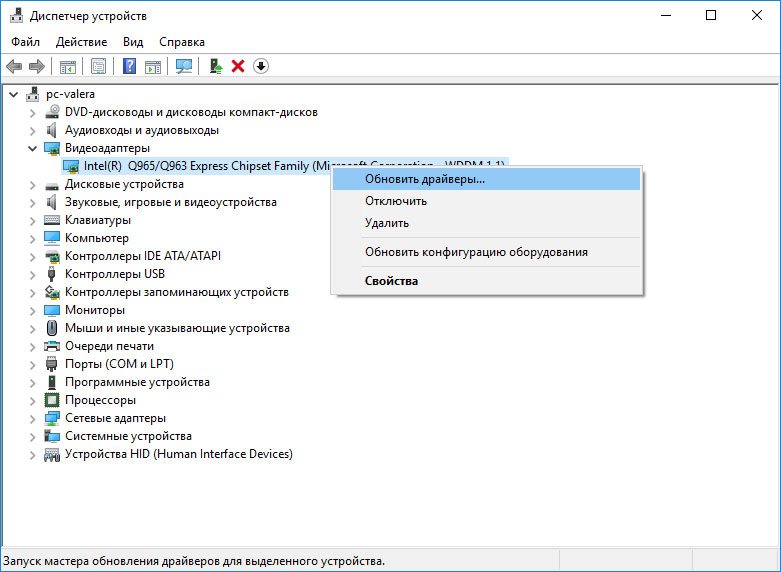
Вы можете сделать это вручную в диспетчере устройств Windows, для того выполните следующие инструкции:
- Нажмите кнопку Windows, затем введите диспетчер устройств с клавиатуры.
- Выберите Диспетчер устройств из списка.
- Просмотрите список категорий устройств, нажмите на стрелочку рядом с категорией вашего нового устройства. Драйвер может быть отмечен желтым треугольником.
- Кликните правой кнопкой мыши на имя устройства и нажмите Обновить драйвер.
- Далее откроется окно Мастера обновления драйверов с двумя опциями:
- Автоматический поиск обновленных драйверов. Windows проверит наличие наиболее подходящего драйвера для этого устройства в автоматическом режиме.
- Выполнить поиск драйверов на этом компьютере. Используйте эту опцию, что бы самостоятельно указать ОС файлы драйвера.
Перезагрузите компьютер после установки драйвера.
Используйте sfc /scannow для проверки всех файлов системы
Повреждение или перезапись системных файлов может привести к ошибке «INTERRUPT_EXCEPTION_NOT_HANDLED». Команда sfc находит поврежденные системные файлы Windows и заменяет их.
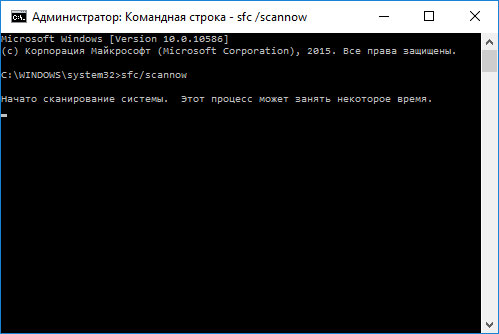
- Нажмите кнопку Windows, затем введите cmd с клавиатуры.
- Правой кнопкой мышки кликните на CMD и запустите от имени администратора.
- В окне командной строки введите sfc /scannow и нажмите Enter.
Этот процесс может занять несколько минут.
Как восстановить системные файлы Windows 10

Проверьте диск с Windows на наличие ошибок командой chkdsk c: /f
Возможно к синему экрану с «INTERRUPT_EXCEPTION_NOT_HANDLED» привела ошибка файловой системы или наличие битых секторов диска. Команда CHKDSK проверяет диск на наличие ошибок файловой системы и битых секторов. Использование параметра /f заставит программу автоматически исправлять найденные на диске ошибки, а параметр /r позволяет найти и «исправить» проблемные сектора диска. Для запуска следуйте инструкциям:
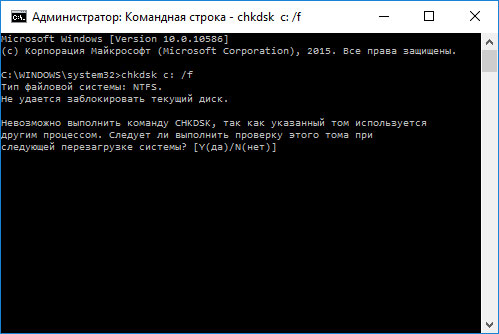
- Нажмите кнопку Windows, затем введите CMD с клавиатуры.
- Правой кнопкой мышки кликните на CMD и запустите от имени администратора.
- В окне командной строки введите chkdsk c: /f и нажмите Enter (используйте ту букву диска, на котором установлена ОС).
Дождитесь окончания процесса и перезагрузите компьютер.
Используйте режим совместимости со старой версией Windows
Отключите лишние программы из автозагрузки Windows
Программное обеспечение, вызывающее «INTERRUPT_EXCEPTION_NOT_HANDLED» (0x0000003D), может быть прописано в автозагрузку Windows и ошибка будет появляться сразу после запуска системы без вашего участия. Удалить программы из автозагрузки можно с помощью Диспетчера задач.
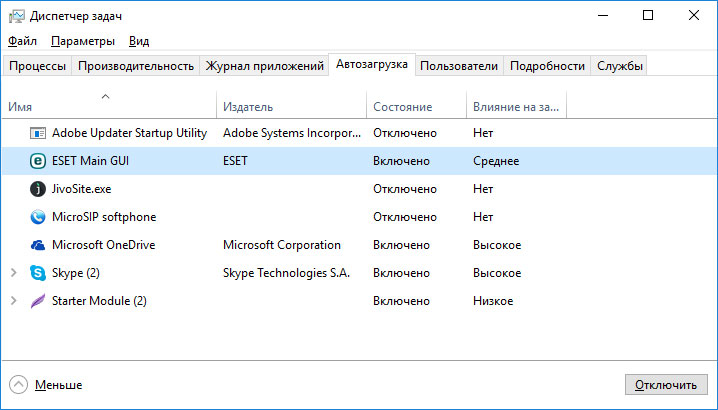
- Загрузитесь в Безопасном режиме.
- Кликните правой кнопкой мышки на Панели задач, затем на пункте Диспетчер задач.
- Перейдите на вкладку Автозагрузка.
- Чтобы убрать ту или иную программу из автозагрузки выберите её из списка и отключите, нажав кнопку Отключить в правом нижнем углу окна.
Обратитесь в поддержку Microsoft
Microsoft предлагает несколько решений удаления ошибки «голубого экрана». «INTERRUPT_EXCEPTION_NOT_HANDLED» (0x0000003D) можно убрать с помощью Центра обновления или обратившись в поддержку Windows.
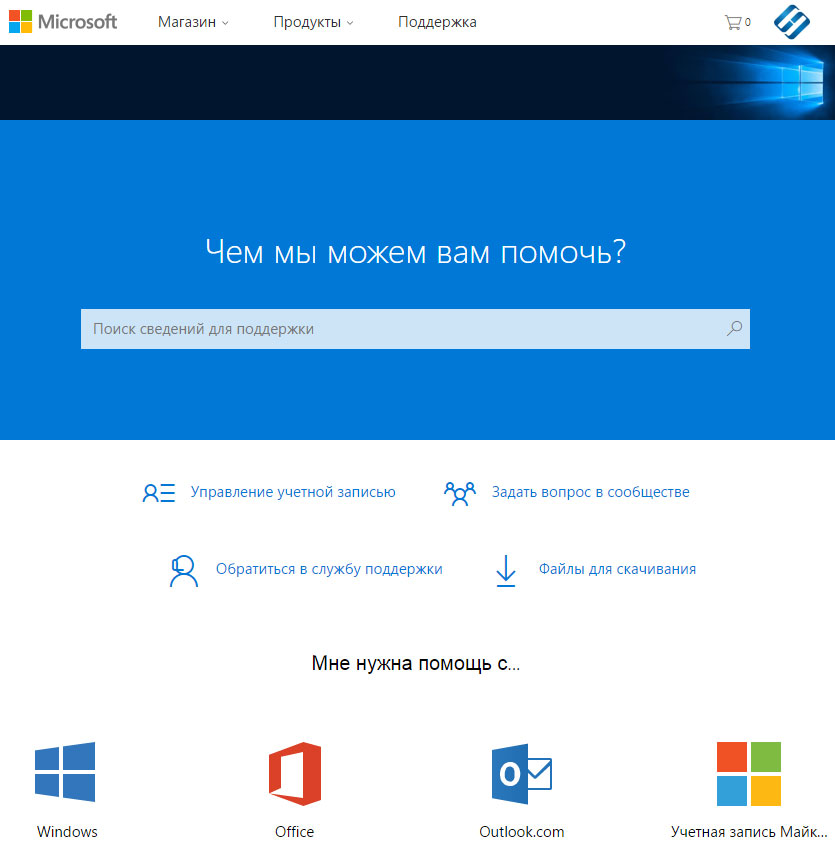
- Перейдите на сайт технической поддержки Microsoft.
- Введите код и сообщение об ошибке в поисковую строку и следуйте найденным рекомендациям.
- Если вы не найдете готового решения, то задайте вопрос в сообществе — возможно вам ответит сертифицированный системный администратор.
Установите последние обновления системы
С обновлениями Windows дополняет базу драйверов, исправляет ошибки и уязвимости в системе безопасности. Загрузите последние обновления, что бы избавиться от ошибки «INTERRUPT_EXCEPTION_NOT_HANDLED» (0x0000003D).
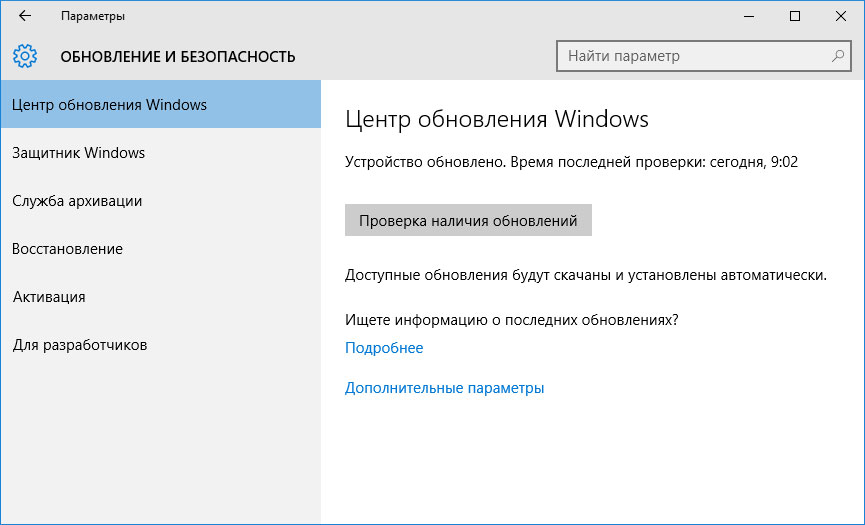
Запустить Центр обновления Windows можно следующим образом:
- Перейдите в меню Пуск и выберите Параметры.
- В окне Параметров перейдите в меню Обновление и Безопасность.
- Для установки последних обновлений Windows нажмите кнопку Проверка наличия обновлений и дождитесь окончания процесса их поиска и установки.

Рекомендуется настроить автоматическую загрузку и установку обновлений операционной системы с помощью меню Дополнительные параметры.
Чтобы включить автоматическое обновление системы необходимо запустить Центр обновления Windows:
- Перейдите в меню Пуск и выберите Параметры.
- В окне Параметров перейдите в меню Обновление и Безопасность и выберите подменю Центр обновления Windows. Для установки последних обновлений Windows нажмите кнопку Проверка наличия обновлений и дождитесь окончания процесса их поиска и установки.
- Перейдите в Дополнительные параметры и выберите, как устанавливать обновления — Автоматически.
Запустите проверку системы на вирусы
«Синий экран смерти» с ошибкой «INTERRUPT_EXCEPTION_NOT_HANDLED» 0x0000003D может вызывать компьютерный вирус, заразивший систему Windows.
Для проверки системы на наличие вирусов запустите установленную на компьютере антивирусную программу.
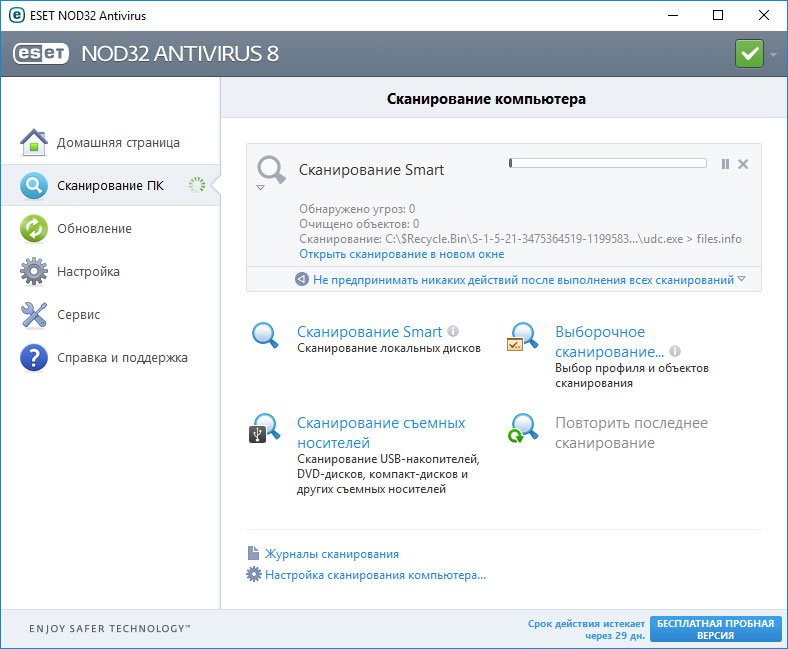
Современные антивирусы позволяют проверить как жесткие диски, так и оперативную память. Выполните полную проверку системы.
Выполните проверку оперативной памяти
Неполадки с памятью могут привести к ошибкам, потере информации или прекращению работы компьютера.
Прежде чем проверять оперативную память, отключите её из разъёма на материнской плате компьютера и повторно вставьте в него. Иногда ошибка INTERRUPT_EXCEPTION_NOT_HANDLED» вызвана неправильно или не плотно вставленной в разъём планкой оперативной памяти, или засорением контактов разъёма.
Если предложенные действия не привели к положительному результату, исправность оперативной памяти можно проверить средствами операционной системы, с помощью средства проверки памяти Windows.
Запустить средство проверки памяти Windows можно двумя способами:
- С помощью Панели управления:
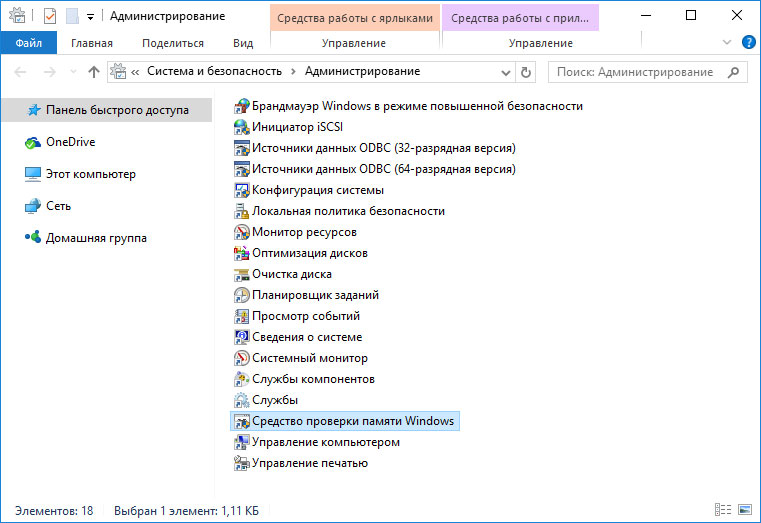
Перейдите в Панель управления / Система и безопасность / Администрирование. Запустите приложение Средство проверки памяти Windows.
- С помощью средства Выполнить:
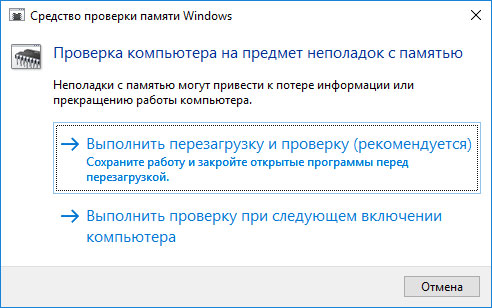
Запустите средство Выполнить с помощью комбинации клавиш Windows + R. Наберите mdsched и нажмите Enter. После чего откроется средство проверки Windows.
Для начала проверки выберите один из предлагаемых вариантов, проверка оперативной памяти в соответствии с которым будет запущена после перезагрузки компьютера.
Если в результате проверки будут определены ошибки, исправить которые не представляется возможным, то такую память необходимо заменить (замене подлежит модуль памяти с неполадками).
Выполните «чистую» установку Windows
Если не один из перечисленных методов не помог избавиться от INTERRUPT_EXCEPTION_NOT_HANDLED», попробуйте переустановить Windows. Для того чтобы выполнить чистую установку Windows необходимо создать установочный диск или другой носитель с которого планируется осуществление установки операционной системы.
Загрузите компьютер из установочного диска. Для этого может понадобиться изменить устройство загрузки в BIOS или UEFI для более современных компьютеров.
Следуя пунктам меню установщика укажите диск, на который вы хотите установить Windows. Для этого понадобится отформатировать его. Если вас не устраивает количество или размер локальных дисков, их можно полностью удалить и заново перераспределить.
Помните, что форматирование, удаление или перераспределения дисков удалит все файлы с жесткого диска.
После указания диска для установки Windows запуститься процесс копирования системных файлов и установки операционной системы. Во время установки от вас не потребуется дополнительных действий. В течении установки экран компьютера будет несколько раз гаснуть на непродолжительное время, и для завершения некоторых этапов установки компьютер будет самостоятельно перезагружаться.
В зависимости от версии Windows на одном из этапов от вас может понадобиться выбрать или внести базовые параметры персонализации, режим работы компьютера в сети, а также параметры учётной записи или создать новую.
После загрузки рабочего стола чистую установку Windows можно считать законченной.
Примечание. Прежде чем приступить к выполнению чистой установки Windows заранее побеспокойтесь о наличии драйверов ко всем установленным устройствам и сохранности ваших файлов. Загрузите и сохраните драйвера на отдельный носитель информации, а для важных данных создайте резервную копию.
Как сбросить Windows 10 к исходному состоянию

Как сбросить Windows 10, 8, 7 если компьютер не загружается

The problem is mainly caused by corrupt drivers
by Madalina Dinita
Madalina has been a Windows fan ever since she got her hands on her first Windows XP computer. She is interested in all things technology, especially emerging technologies… read more
Updated on May 30, 2023
Reviewed by
Vlad Turiceanu

Passionate about technology, Windows, and everything that has a power button, he spent most of his time developing new skills and learning more about the tech world. Coming… read more
- Many errors like Error 0x803F7000 On Windows 10 can be easily fixed by following our guides, so follow the solutions below correctly.
- If updating our drivers didn’t do the trick, you should try a much more straightforward solution, running an SFC scan.
- As a last resort, you may reinstall the operating system, but be mindful since you may lose some data.
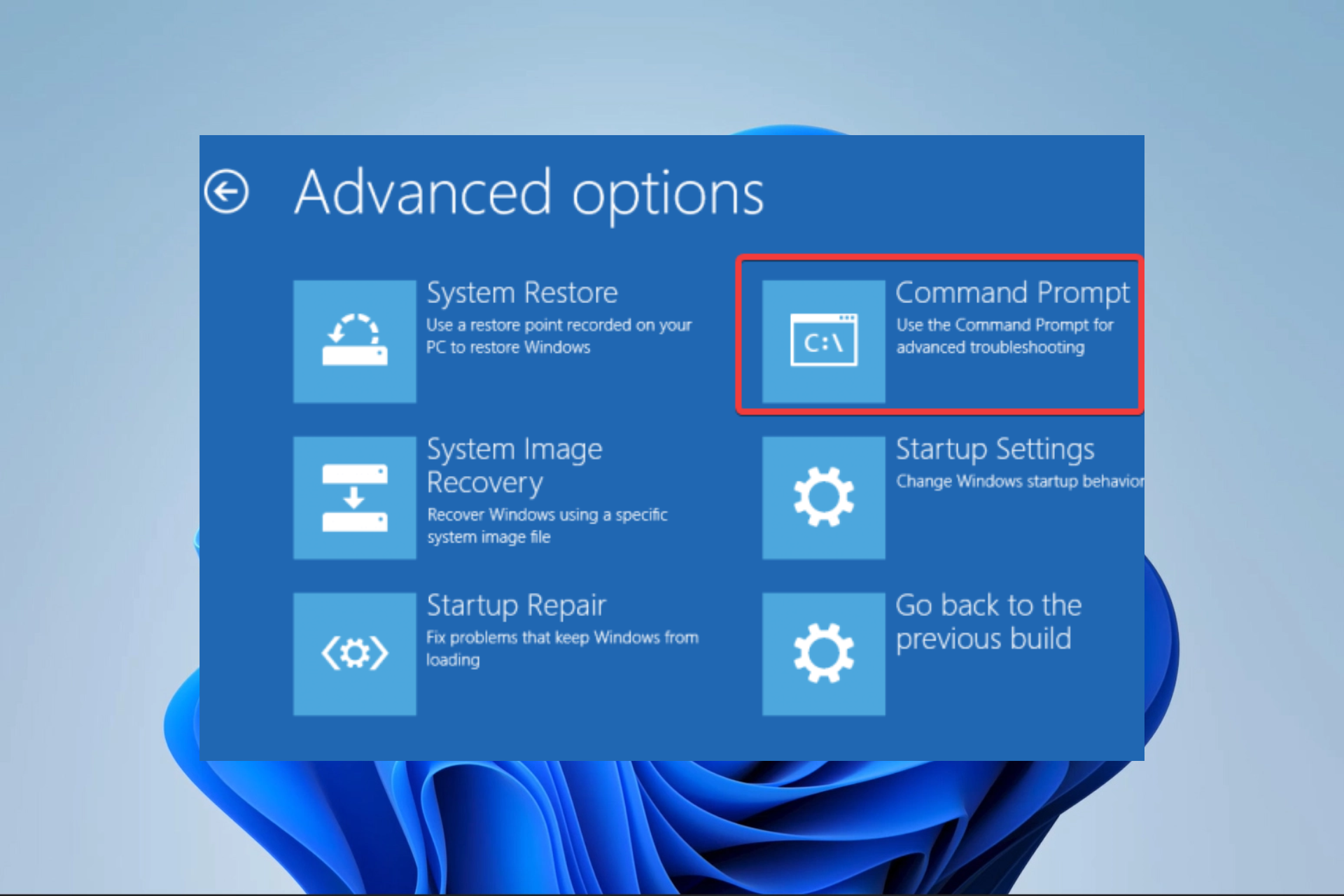
XINSTALL BY CLICKING THE DOWNLOAD FILE
Fortect is a tool that does not simply cleans up your PC, but has a repository with several millions of Windows System files stored in their initial version. When your PC encounters a problem, Fortect will fix it for you, by replacing bad files with fresh versions. To fix your current PC issue, here are the steps you need to take:
- Download Fortect and install it on your PC.
- Start the tool’s scanning process to look for corrupt files that are the source of your problem
- Right-click on Start Repair so the tool could start the fixing algorythm
- Fortect has been downloaded by 0 readers this month.
Windows 10 is a significant step towards a unified Windows ecosystem by Microsoft – that is part of the reason why Microsoft made it a free upgrade.
To make a unified ecosystem, you must have as many people as possible on the platform. And that is why a free upgrade makes sense and is necessary for the progress of this ecosystem.
Unfortunately – the free upgrade offer was exactly as its name suggests, an upgrade. And Windows upgrades are not something with an excellent reputation regarding stability.
This article will focus on the interrupt exception not handled blue screen error.
What causes the interrupt exception not handled error?
If you were wondering about the Interrupt exception not handled meaning, it’s a BSOD error caused due a bunch of reasons.
Various things can cause this error, but it is a driver problem most of the time. For example, sometimes, the drivers from your older Windows install refuse to work with Windows 10 after an upgrade and cause this blue screen error.
The Windows 10 setup is, of course, supposed to look for such drivers and update them itself. Unfortunately, however, it doesn’t always work.
So for the first solution, we will try and update the drivers. But before we carry on, here are some more examples of this problem:
- Interrupt exception not handled Windows 7 – Although we’re talking about Windows 10, this issue can also appear in Windows 7. Nevertheless, you can still use most of the solutions from this article.
- Windows 10 stop code interrupt exception not handled – The most common causes of this blue screen issues are obsolete or corrupted drivers, a damaged Windows registry, etc. This is users’ most frequent blue screen issue when upgrading their Windows.
- Windows 10 blue screen interrupt exception not handled – This is very similar to the Windows 10 stop code interrupt exception not handled error, and similar solutions will apply.
- Blue Screen 0x0000003d – This error code is usually associated with the INTERRUPT EXCEPTION NOT HANDLED issue in Windows 10. So, if it appears, you can still use the same solutions.
- Interrupt exception not handled overclock – According to some users, the INTERRUPT EXCEPTION NOT HANDLED can sometimes happen if your CPU is overclocked.
- Kmode exception not handled Windows 11 – Usually caused by conflicts between driver, and can be easily fixed in no time.
- 0x0000000A Windows 11 – Caused due to a bug in the CPU or corruptions with the memory.
- Interrupt exception not handled VMware – Many reported encountering the error when trying to install or launch VMware.
Additionally, users have experienced Interrupt Exception not Handled in VMware, Kmode, Java, and ntoskrnl.exe.
Many errors like Error 0x803F7000 On Windows 10 can be easily fixed by following our guides, so follow the solutions below correctly.
How do I stop system thread exception not handled Windows 11?
1. Update your drivers
1.1 Update your drivers manually
- Right-click on the Start menu and Select the Device Manager.
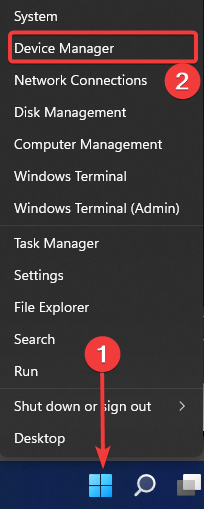
- Right-click on your drivers individually and select Update driver.
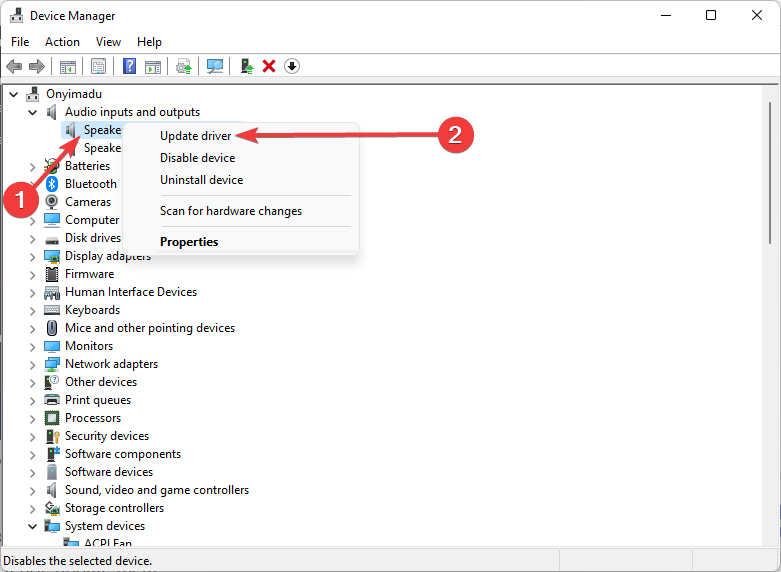
- Select Search automatically for driver.
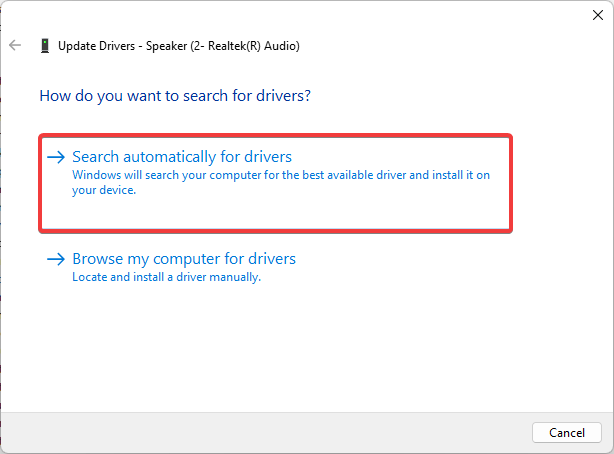
- Repeat steps 2 and 3 for all your drivers, then restart the computer.
Outdated or wrong drivers can create a big mess on your PC. So you need to make sure you have updated drivers and if not, update them.
Not only do you need to update your drivers for the big hardware, such as your graphics card, but you also need to update your drivers for the various chips in your motherboard.
1.2 Update drivers automatically
Searching for drivers on your own can be time-consuming. So, we advise you to use a tool automatically to do this for you.
Using an automatic driver updater will save you from the hassle of manually searching for drivers and keep your system updated with the latest drivers.
Some PC issues are hard to tackle, especially when it comes to missing or corrupted system files and repositories of your Windows.
Be sure to use a dedicated tool, such as Fortect, which will scan and replace your broken files with their fresh versions from its repository.
Outbyte Driver Updater will help you update drivers automatically and prevent PC damage caused by installing the wrong driver versions.
After several tests, our team concluded that this is the best-automatized solution.

Outbyte Driver Updater
Benefit from detailed and thorough reports and the latest updates for your device drivers.
2. Run the BSOD Troubleshooter
- Open the Settings app and go to the Update & Security section.

- Select Troubleshoot from the menu on the left.
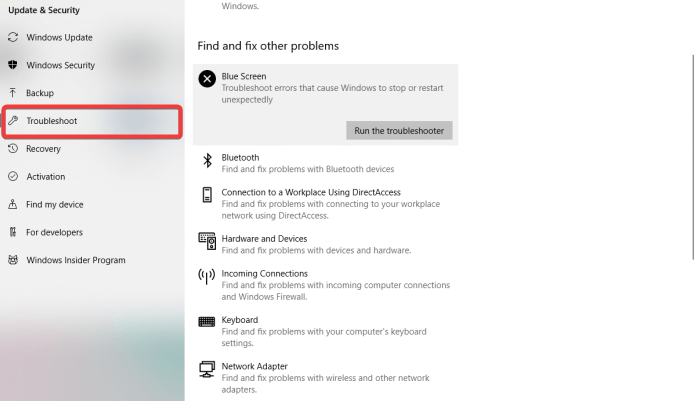
- Select Blue Screen from the right pane and click Run the troubleshooter.
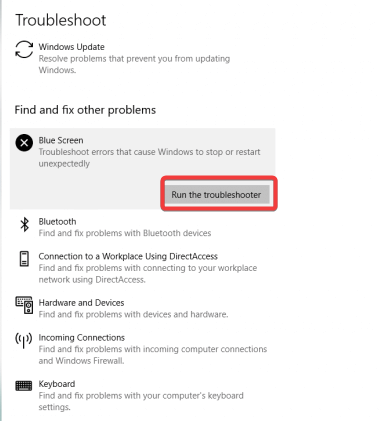
- Follow the instructions on the screen to complete the troubleshooter.
3. Use the SFC scan
- Right-click on the Start menu button and open Command Prompt (Admin).
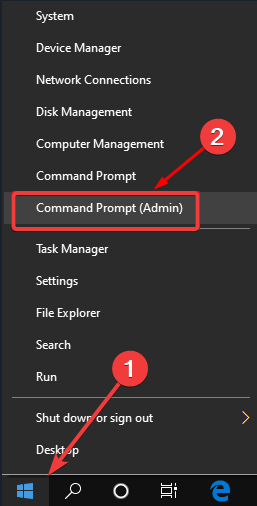
- Enter the script below and hit Enter.
sfc /scannow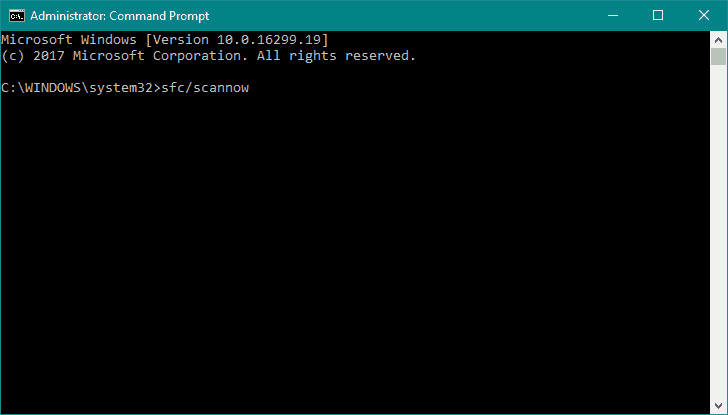
- Wait until the process is done (it may take a while).
- If the solution is found, it will automatically be applied.
- Now, close the Command Prompt and restart your computer.
The SFC scan is another troubleshooting tool that can help with BSOD issues. So, if Windows 10’s built-in troubleshooter didn’t resolve the problem, the SFC scan is a tool worth running.
- Fix: Machine Check Exception in Windows 10/11 [Full Guide]
- Fix: Unexpected Store Exception error in Windows 10/11
4. Run DISM
- Right-click on the Start menu button and open Command Prompt (Admin).

- Paste the following command and press Enter:
DISM /Online /Cleanup-Image /RestoreHealth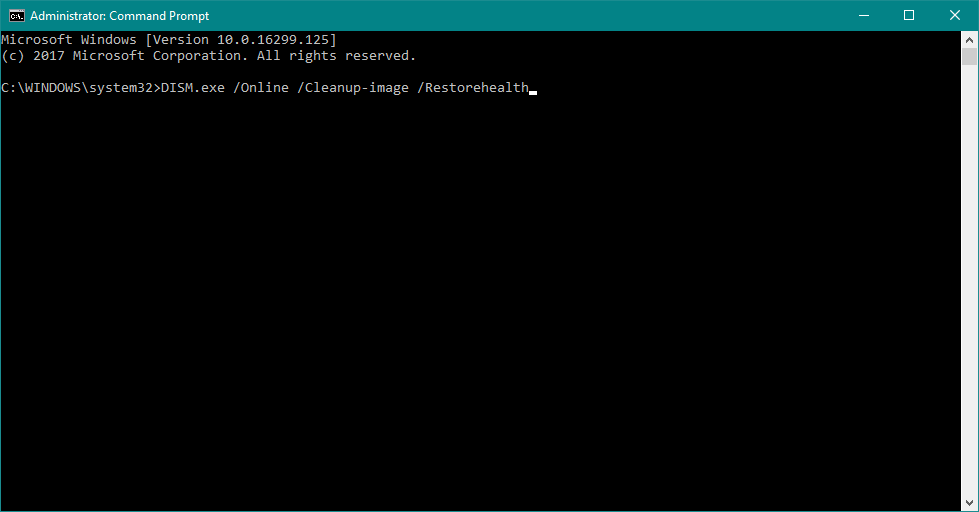
- Wait until the scan is finished, restart your computer and try updating again.
Deployment Image Servicing and Management (DISM) is a powerful tool that freshly deploys the system image. And that process can eliminate potential BSOD issues.
5. Check the hard drive
- Enter the Advanced Startup (Restart your computer while holding the Shift key).
- Choose Troubleshoot > Advanced Options.

- Select Command Prompt from the list of options.
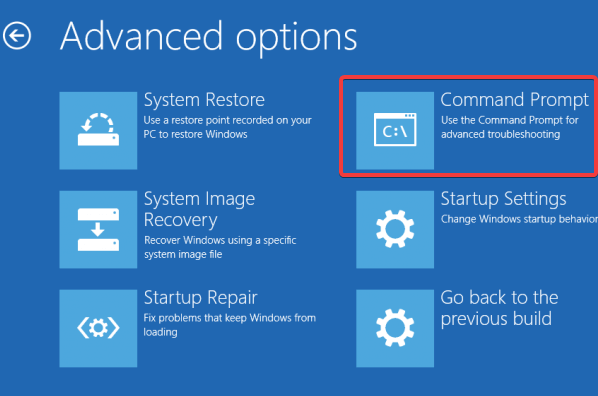
- When Command Prompt appears, enter the following lines and press Enter after each line to run it:
bootrec.exe /rebuildbcdbootrec.exe /fixmbrbootrec.exe /fixboot
- Now input the script below and hit Enter to double-check if the hard disk isn’t corrupt.
chkdsk
- Restart your computer and check if the issue is resolved.
How do I fix Interrupt Exception not Handled on Windows 11?
If you have read this far, here is the good news – you already know how to fix Interrupt Exception not Handled on Windows 11.
This is because the two Windows operating systems are very similar, and since the same reasons on both trigger the error, the solutions that have worked on Windows 10 will also apply to Windows 11.
On infrequent occasions, you may encounter slight UI differences, but generally, you should be able to apply the same steps.
Can overclock cause Interrupt Exception Not Handled?
Some users have reported that if your CPU is overclocked, the Interrupt Exception Not Handled can occasionally occur.
Hence, you should be wary of this and avoid overclocking. Many crashes have been a result of overclocking system resources.
However, if that is the case, you can now use any of the solutions we have shared to repair your computer.
That is as far as we will discuss in this guide.
Note that reinstalling the OS is another option, but we usually will only resort to it as the last option when other solutions fail.
Reinstalling Windows 10 is relatively straightforward, and since your License key is now linked to your PC and stored in the cloud – you don’t need to remember it anymore.
Simply format your disk, and reinstall Windows 10. You will lose all your data, though, so make sure to back up your data before you do any of this.
Let us know what solution worked for you in the comments section below.
![]()
Do you find INTERRUPT_EXCEPTION_NOT_HANDLED error on your Windows 10 desktop while starting any program or closing? Being a BSOD issue, system experiences continuous restart without prior notice along with weird texts. Furthermore, it holds a bug check value of 0x0000003D which also leads to freeze and hang.
The main causes behind this Blue Screen of Death are outdated device drivers. Other reasons involve malware infection, a conflict between similar programs, troublesome memory, missing DLL files, and faulty Windows image files. Addition to these, low disk space in the HDD, problematic areas present in it and often using an extra drive might also create the issue. You need to take necessary actions to limit its effects so here is the description of some workarounds which can solve INTERRUPT EXCEPTION NOT HANDLED error easily. Solutions list is as follows –
INTERRUPT_EXCEPTION_NOT_HANDLEDBSOD in Windows 10 Solutions
Here is how to fix INTERRUPT_EXCEPTION_NOT_HANDLED BSOD in Windows 10 –
1] Restrict Automatic Restarting of Windows 10
The most annoying conception about BSOD error in Windows is, it will try to reboot by itself anytime without even noticing the user. At the same time, due to lack of opportunity, applying resolutions will be impossible as well. The same is applicable to INTERRUPT_EXCEPTION_NOT_HANDLED blue screen of death error. Therefore, first thing first, you must disable this action following through below guidelines –
Step-1: Press Win+D and head to the Desktop screen after saving all the ongoing programs.
Step-2: Make a right click on the This PC icon and choose Properties from the menu.
Step-3: When the System Properties comes into view, select “Advanced system settings” located at the left-hand side.
Step-4: In a while, a wizard will unroll on the screen named System Properties. Switch to Advanced tab.
Step-5: Navigate to the Startup and Recovery block and perform a click on Settings button located here.
Step-6: Windows will show up now a Startup and Recovery window on display. Proceed ahead to its System failure area.
Step-7: In due course, uncheck the box beside option Automatically restart to continue.

Step-8: Finally, hit the Apply and then OK to save the modifications.
That’s it, Windows will now restrict the device from rebooting automatically. Thereafter, you will have sufficient time to sort out the issue.
2] Update Drivers via Windows Device Manager
We have mentioned earlier in the above section that, outdated and defective device drivers play a bigger role in causing “INTERRUPT_EXCEPTION_NOT_HANDLED” BSOD in Windows 10. Therefore, updating these would resolve the error at the same time can resist many other vulnerabilities. Device Manager shows these drivers in yellow indication and thus, the task becomes a lot easier to accomplish. Here are the steps to follow –
- Do a combined press of Win & S keys and invoke Taskbar search on display.
- When it shows up, type Device Manager in the null search box and also select it when available in the result.
- Moving ahead to the console, have a closer look at the devices having an exclamation mark at its side.
- If you notice any, do a click on that very device to expand the driver’s list.
- Right click on the drivers and choose the option namely “Update driver” from the menu. Keep on moving with the instructions to complete the update procedure.

- Do the same for all the devices showing exclamation mark and lastly ensure to reboot the device. Hopefully, there will be no more INTERRUPT_EXCEPTION_NOT_HANDLED BSOD in Windows 10 afterward.
3] Use the Windows Blue Screen Troubleshooter to deal with BSOD issues
BSOD errors like INTERRUPT_EXCEPTION_NOT_HANDLED found to cause serious damage to Windows. Seeing the devastation, Microsoft technicians came out with a new default utility that can effectively fix this issue. A utility named Windows Blue Screen Troubleshooter was introduced in Windows 10 Fall Creators Update. Here is how to use the default tool –
- Press Windows and I keys together and call up the Settings app.
- Select Update & Security.
- When the succeeding page loads completely, choose Troubleshoot from the left layout.
- Now, jump on to the alternative pane and reach out to Blue Screen option.
- Make a click on it and hit Run the Troubleshooter button and apply the utility.
This tool will, therefore, resolve the INTERRUPT_EXCEPTION_NOT_HANDLED BSOD in Windows 10. In the end, you can stay out of any trouble and work smoothly.
4] Load only Basic Processes using Safe Mode
Starting after the development, Windows has been indulged in many known and unknown issues. Every time in critical error, Booting in the Safe Mode was a rescuer. In this special Startup method, the device starts with loading only basic processes that heal the most. To apply this process, the guidelines are as following –
- Click on the Start.
- When it launches, select Power icon and also choose Restart holding Shift key at the same time.
- In cooperating with the action, Windows will reboot normally and when it boots up to Start you will come across a Blue screen showing few options.
- Make a click on the Troubleshoot option and load the next screen.
- On this page, select Advanced options and in the process, hit Startup Settings.
- In the consequent move, click on the Power icon located at the bottom right most end of this screen. Allow the device to reboot for the second time.
- After the Startup screen will come in, you will see a collection of options including one to Enable Safe Mode.
- At this moment, Press F4 button at a stretch to enter into the Safe Mode.
Once moved to the Safe Mode, there shouldn’t be any more INTERRUPT_EXCEPTION_NOT_HANDLED BSOD in Windows 10.
5] Don’t keep the Update patches pending, Install immediately
Every single cumulative patch comes with the latest features and fixes of existing bugs. Installing them strengthen the Operating System. Since an outdated OS always at a higher risk of getting affected with INTERRUPT_EXCEPTION_NOT_HANDLED BSOD error. Thus, let’s step out for installing them by going through the below instructions –
Important – You need to get connected with a speedy internet connection to download these files quickly. Try to get connected with Wi-Fi or broadband providers. If you have to use the “Mobile Hotspot”, disable Metered connection in the Network Settings.
- Click the Start button.
- Once the menu appears, select the Settings icon. And let the app to launch in a separate window.
- Proceeding forward, select Update & Security tile and load its additional setting page.
- After transferring to the succeeding page, select Windows Update from the left wing and jump to the corresponding pane.
- On the right, ignore the dialog showing “You’re up to date” and at the same time, perform a click on Check for updates button under it.

- Once the searching process ends and patches are available, select the Download button located under all.
- Upon finishing the downloading process, the installation begins automatically. Keep your eyes on the screen for further instructions coming here.
- Do Restart once asked and update the Windows completely.
6] Remove Applications conflicting to fix INTERRUPT_EXCEPTION_NOT_HANDLED
If two similar kinds of applications in the Windows stay in parallel, they often come in contact with each other. In the end, many important files go missing. This action results in occurring INTERRUPT_EXCEPTION_NOT_HANDLED BSOD in particular. The resolution is very simple, we need to uninstall one from them. To remove one program from the system, follow below instructions –
- Open the Windows Settings app by pressing “Win+I” keys together.
- When in the layout, select Apps in this layout and proceed to more settings page.
- Choose Apps & features from left wing side when the succeeding page loads.
- Pass over to adjacent pane in due course.
- Moving ahead on the right, reach out to the Apps causing INTERRUPT_EXCEPTION_NOT_HANDLED BSOD error in the list.
- Select it and also hit Uninstall option from the expanded pane.
- When UAC prompts for permission, choose Yes to provide the consent.
- Perform the next moves according to the instructions available on display.
- When these are uninstalled, restart the device using a convenient way.
- Upon startup, check for the BSOD error in the system. If nothing comes up, install those programs if required.
7] Unplug external Hardware devices and reconnect once INTERRUPT_EXCEPTION_NOT_HANDLED BSOD resolves
Sometimes, people might experience the INTERRUPT_EXCEPTION_NOT_HANDLED BSOD in their respective systems after using hardware items. An External hard drive in particular. So many people around the world have resolved the issue only by offering these devices a temporary break. Accomplish the task using the below guidelines –
- As for the initial move, disconnect the hardware accessories in order and place them in an accessible location.
- Restart Windows 10 PC.
- After the cycle of rebooting completes, perform an inspection for the existence of BSOD error.
- If no issue shows up next, plug in all the separated accessory one by one.
- Now, launch the web browser from the computer and visit the manufacturer website for respective items.
- Download and install again the latest drivers from there.
8] Launch Windows Security and abolish all the Malware
Nowadays, it’s really hard to stay from viruses since they are present in every corner of the web. When you visit a malicious website or do a click on the suspicious link coming in Spam mail, they get entrance to the system. Once there, deteriorates the system components and INTERRUPT_EXCEPTION_NOT_HANDLED BSOD evolves. Therefore, we need to clean them immediately as soon as diagnosed and in this concern, Windows Security app can offer the best deal. See the method in below segment –
- Open the Taskbar Search, type “Windows Security” in the empty text area provided and select the same when it shows up in the result.
- Moving on to the app interface, choose Virus & threat protection from the left side and also move to the corresponding overlay.
- On the right, select Scan options link to spread up the detection methods.
- In the continuation of the task, choose the radio button before Full scan.

- In due course, hit Scan now button and let the process begin.
- Upon finishing up the scan, you will see the result. If any malware present, select Clean threats and dismiss them.
- On the next page, among three options available, select Remove and later on Start actions button to start the removal.
9] Put an end to the Memory issues
You might get the INTERRUPT_EXCEPTION_NOT_HANDLED BSOD error when Windows suffer in memory issues like incorrect allocation and defective areas in RAM. To abolish these problems, Microsoft has developed Windows Memory Diagnostic and this default tool detects and fixes those issues in the most effective way. To use the tool, instructions are as follows –
- Get access to the Settings app and once you come across the search box in the UI, type memory.
- Select “Diagnose your computer’s memory problems” from the visible list.
- When the utility shows up in the popup, choose “Restart now and check for problems (recommended)” option.

- In a short interval, Windows 10 will restart. When it signs back in afterward, a Blue screen will come in display and start detecting memory issues.
- Once the progress hits 100%, the system will reboot again automatically. Upon coming back to operation later, results will be available in the System Tray of the Notification area.
10] Clear up the Junk files to make more space in Disk
Windows 10 produces lots of junk files every day and stores them in disk space. These files are unnecessary and will come to no use eventually later on. Furthermore, when they pile up in a big amount, occupy huge disk space. As a result, the normal functionality deteriorates and INTERRUPT_EXCEPTION_NOT_HANDLED BSOD evolves. We have the Disk Cleanup tool to delete these files in a single shot. To access the tool, follow the below steps –
Step#1: Hover the cursor to Start menu and do a right click on it.
Step#2: Select Run option listed there and invoke the dialog on the screen.
Step#3: Type cleanmgr in the void box available here and hit Enter key eventually.
Step#4: A small popup will appear shortly as for the action and ask you to select the drive where you opt to carry out freeing up the task.
Step#5: Choose C: by clicking on the available dropdown menu and also select OK option seen here.
Step#6: The Disk Cleanup utility will first calculate the space in volume it can recover.
Step#7: When it is available in the wizard, move down a little and hit Clean up system files button.

Step#8: The small popup dialog will appear again. Select the same drive like before and hit Ok.
Step#9: Disk Cleanup for C: will again calculate retrievable space in the drive and throw new wizard on the screen.
Step#10: Now, head to Files to delete section and check all the boxes leaving Downloads.
Step#11: Now, Select Ok to initiate cleaning.
Step#12: The process will take some time to finish up, so do wait patiently until it ends. Restart the device and when comes back to desktop later, see if the error is resolved.
Note- Before starting the deleting process, perform a check in Recycle Bin for necessary items. If anything present, restore them in respective locations.
11] Remove Faulty Windows Update Files
Usually, this is rare to have any issues in the autonomous Windows Updating procedure while doing through the Settings app. Unfortunately, if the process terminates abnormally anytime, INTERRUPT_EXCEPTION_NOT_HANDLED BSOD error will be imminent. To safeguard the system, these dreadful files need to be removed soonest possible. You can use the below guidelines to delete those files –
- Open the Windows Settings app using any of the conventional methods.
- When it unrolls, proceed to the Update & Security tile and eventually do a click on it.
- Upon loading the consequent page, select Windows Update from the left side.
- Jumping ahead to the corresponding right, perform a click on the link saying “View update history”.
- After shifting to the succeeding window, choose the option namely Uninstall updates.

- In a moment, the Installed Updates window will come up.
- Reach out to the last cumulative patch in the list and do a right click on it.
- Hit Uninstall option once visible in the upper ribbon.
- Follow on-screen instructions appearing to delete those files completely.
12] Detect the Poor areas in Hard Disk and resolve using the Disk Checking tool
Hard Disk Areas might have poor areas present as for using it day after day. When such segments evolve, INTERRUPT_EXCEPTION_NOT_HANDLED BSOD is eminent as well. To settle down these, Disk Checking Utility comes handy. The detailed process is stated below –
- Make a together press of Win+ S hotkeys and invoke the Taskbar Search.
- When it appears on display, type cmd.exe in the empty space provided and do a right click on Command Prompt when visible in the result.
- Select Run as Administrator and also choose Yes once User Account Control prompts.
- On the elevated Command Prompt, type the command in the following arrangement –
chkdsk [Drive:] [parameters]
- Press Enter key and the utility will show only the status of the disk. To recover these poor areas present, you have to add more suffix like below –
/f /r /x
Here,
- f- Fixes the defective areas found in the volume.
- r- Finds out poor sectors in the volume.
- x- Splits up the volume for detection before the process starts.
Finally, the complete command with all notations look like-
chkdsk C: /f /r /x
- C: drive is added here as we have installed the Windows 10 in this drive. You can replace it by D:, E: based on where you have stored the OS.
- Now, Hit Enter key and let the Disk Checking Utility take over charge. Detection and fixing will be done automatically and you just need to wait patiently.
- When the process ends finally, perform a Reboot to the device and afterward check if the error is there or not.
13] Revert all the recent Changes using System Restore
Any changes made on Windows like installing a program or uninstalling another leaves mark in the Windows Registry. When something goes either way in this system, INTERRUPT_EXCEPTION_NOT_HANDLED BSOD comes up. Using System Restore makes these changes undo if the presence of a previously created restore point. If you don’t have such points, we recommend to leave this resolution here and proceed for next. If you have, follow the below guidelines-
- Open Run dialog box by pressing “Win+R” keys together.
- Type rstrui in the search field and also press Enter key.
- When System Restore opens up, hit Next to move ahead.
- From the succeeding page, select Show more restore points.
- Hut the last one and hit Next option.
- Moving ahead to the consequent page, perform a click on Finish and initiate the restoring process.
14] Fix up the Corrupted System Resources and Recover DLL files
When Windows system components indulge in corruption, INTERRUPT_EXCEPTION_NOT_HANDLED BSOD evolves immediately. Missing DLL files causes the same as well and in this regard, System File Checker will effectively make an attempt to resolve these issues in the most fruitful way. To call in the tool, move with below guidelines –
- Press Ctrl+Alt+Del keys altogether and select Task Manager when a page show up.
- Moving ahead, click File located at the upper left corner. Choose Run a new task option to launch a dialog.
- Type cmd in the null search area to proceed ahead.
- Do put a checkmark on the box ahead of “Create this task with administrative privileges”.
- Now, Hit Enter key and head to the Elevated Command Prompt directly.
- Once the black window is upfront, type
sfc/ scannowcommand and hit Enter. - System File Checker will start searching for corrupted system elements and fix automatically.
- Be patient and wait till the process ends normally. Restart the device when it finishes and upon returning to the desktop, check if the INTERRUPT_EXCEPTION_NOT_HANDLED BSOD in Windows 10 has resolved.
15] Uninstall Third Party Anti-virus programs now
Malware is the worst enemies these days and we are no longer safe from them. You can use a third party anti-virus tool to dismiss them. But, Windows Security is the best program in this case. You don’t really need them actually. Besides, using a third party app might cause INTERRUPT_EXCEPTION_NOT_HANDLED BSOD error as well. You can immediately step up to uninstall them using below instructions –
- Invoke the Run dialog in the display by pressing Windows and R keys together.
- In the empty search field, type appwiz.cpl and hit the Enter key.
- Programs and features will flash up from Control Panel and list of install apps will be available.
- Move out for the third party Anti-virus tool the list.
- Make a right click on the same and also hit Uninstall option once available.
- Perform the further move according to the instructions available on display until the app uninstalls completely.
16] Execute DISM tool to rectify Windows image files
Dreadful Windows Image Files plays a greater role in causing INTERRUPT_EXCEPTION_NOT_HANDLED BSOD and to deal with this, DISM tool is well renowned. Here is how to move on to the utility –
- Manage the entrance to the Elevated Command Prompt using the above guidelines shown.
- When in the black window appearing next, type the following command at the root of winking cursor –
DISM.exe /Online /Cleanup-image /Restorehealth
- Hit Enter button from keyboard and let the DISM tool to take action.
- This process might take about 10 minutes and more. Be a little patient until the process ends completely.
- Once it gets over, perform a restart and once sign back again, check for BSOD issues in the system.
These are the collection of most effective resolutions owing to INTERRUPT_EXCEPTION_NOT_HANDLED BSOD in Windows 10. We expect that you have resolved the error already and using the device smoothly. Unfortunately, if someone fails to fix the issue, it’s frustrating though. In that case, you can perform Clean installation of Windows 10 again. This will be the last resort and there will be no more issues if done accurately.
After coming to a decision to perform the task, make sure you have managed the following things –
- First of all, get the device connected with speedy internet network via Ethernet cable or connect to Wi-Fi.
- Create a backup folder and save all the necessary items in it. Take it out in USB or external Hard Drive to avoid losing them when required.
- Being a professional workaround, it might be a little complex to you as a regular user. Therefore, seek help from professionals or skilled personnel to do the task.
Methods:
1] Restrict Automatic Restarting of Windows 10
2] Update Drivers via Windows Device Manager
3] Use the Windows Blue Screen Troubleshooter to deal with BSOD issues
4] Load only Basic Processes using Safe Mode
5] Don’t keep the Update patches pending, Install immediately
6] Remove Applications conflicting with each other
7] Unplug external Hardware devices and reconnect
8] Launch Windows Security and abolish all the Malware
9] Put an end to the Memory issues
10] Clear up the Junk files to make more space in Disk
11] Remove Faulty Windows Update Files
12] Detect the Poor areas in Hard Disk
13] Revert all the recent Changes using System Restore
14] Fix up the Corrupted System Resources and Recover DLL files
15] Uninstall Third Party Anti-virus programs now
16] Execute DISM tool to rectify Windows image files
That’s all!!
Repair any Windows problems such as Blue/Black Screen, DLL, Exe, application, Regisrty error and quickly recover system from issues using Reimage.
» Interrupt Exception Not Handled » is a a blue screen error which normally can be seen after the installation of new hardware or software. Following this, the system continuously restarts preventing from accessing windows.
It is one of the BSOD errors, a lot of windows users face during the recent times. Most at times, this error is caused by a driver issue. Al though there exists lots of causes for this error message, the problem comes with some common solutions which help you to fix this error easily.
In this article, I will be covering about 7 Ways to Fix Interrupt Exception Not Handled in Windows. You can get rid this easily by following the solutions carefully.
Let’s get started,
1. Perform SFC Scan
System File Checker (SFC) is a popular tool available to fix blue screen of death problems. This includes Interrupt exception not handled error too. So by running SFC scan you can try to fix this error on your windows PC.
To perform SFC scan,
- Insert the installation media
- Restart the PC
- Boot from the installation media
- Choose your language
- Press Shift + F10
- Type and press Enter after the command
» SFC/Scannow »
2. Perform DISM
Most often corrupted system images are also known to cause Interrupt exception not handled error. DISM is another tool available to replace corrupted system images. Thus, this process can potentially eliminate this error.
To perform DISM,
- Insert the installation media
- Restart the PC
- Boot from the installation media
- Choose your language
- Press Shift + F10
- Type and press Enter after the command
dism/online/cleanup-image/scanhealth
dism/online/cleanup-image/restorehealth
After each command press Enter
7. Again type,
dism/online/cleanup- image/restorehealth/source:wim:X:sourcesinstall.wim:1/Limitaccess
( X refers to the drive mounted )
After each command press Enter
3. Update Drivers
Outdated or misconfigured drivers can pose various issues including Interrupt exception not handled error. Therefore, make sure that each hardware component is updated with latest drivers. Usually the drivers are readily available on the manufacturer’s website. Or else, you can use the device manager to update each drivers manually.
4. Check Hard drive
Users might also experience Interrupt exception not handled after using a malfunctioning hardware devices. Especially, a faulty hard disk drive. You can resolve the issue immediately once you have replaced the faulty hard drive. Hence, it is worth checking the hard drive.
5. Uninstall Antivirus
Antivirus solutions are well known tool to prevent virus attacks. Even so, they could be also one of the reasons for Interrupt exception not handled error. In this case, you need to immediately uninstall them.
6. Perform System Restore
Installation and uninstallation of application brings up changes in the windows registry. This could be another reason for Interrupt exception not handled error. Using the previously created restore points you can easily undo those changes.
To Restore System,
- Insert the installation media
- Restart the PC
- Boot from the installation media
- Choose your language
- Select troubleshoot
- Select » System Restore »
7. Run Blue Screen Troubleshooter
Similar to other blue screen errors, Interrupt exception not handled error too can cause serious damages to the system. So to prevent this, windows comes with their own built in tool called blue screen troubleshooter. This tool has the potential to fix most issues in the windows computer.

